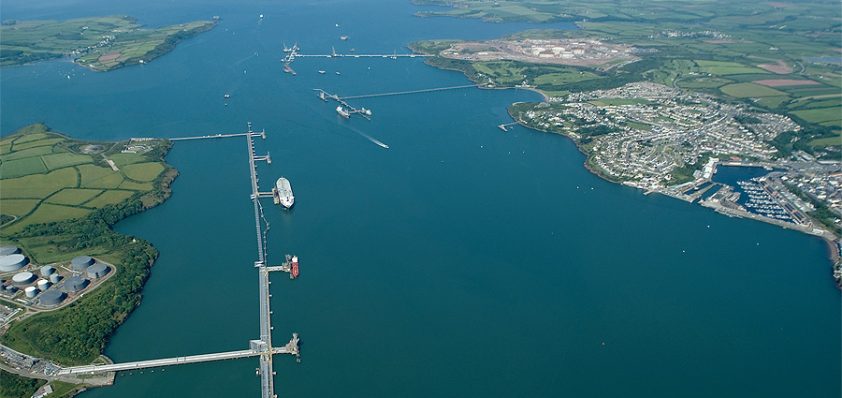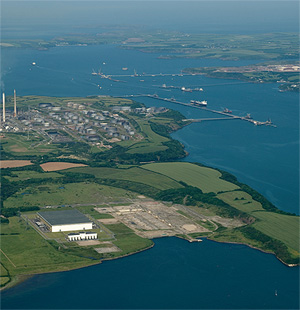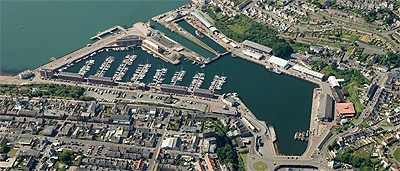
Milford Haven Port Authority
First port of call
Milford Haven Port Authority is responsible for the port of Milford Haven, one of the largest oil and gas ports in Europe, and the fifth largest in the UK.
It houses a number of important oil and gas facilities, and is currently supporting the development of two LNG terminals, which will contribute significantly to the UK’s gas requirements. In addition, the port has a range of other services and facilities, including a ferry terminal used by Irish Ferries, cargo berths, a marina, fishing berths and a dry dock and ship repair facility, together  with numerous residential and retail developments.
with numerous residential and retail developments.
Ted Sangster, chief executive at Milford Haven Port Authority elaborates on the port’s oil and gas operations: “Milford Haven is the fifth largest port in the UK in terms of cargo – around 35 million tonnes of cargo goes through this site each year. We were originally established in 1958 by an Act of Parliament as a trust port to support the oil industry coming into the port area from the Middle East. The chief reason for this was the need at the time for extra refining capacity in the UK, and the advantages that the Milford Haven waterway had was its deep water – we are one of the deepest water ports in the UK – and we are in the South Western approaches, which is well positioned in respect of where the oil was coming from at the time.
“Today the port encompasses 22 miles of waterway, 60 square miles of waterway, and 177 miles of coastline, and is one of the largest oil and gas ports in Northern Europe,” Ted continues. “We currently have two refineries as our customers at Milford Haven – Chevron, which has a capacity for about 200,000 barrels of oil a day – and Total, which produces around half of that and has recently announced its intention to sell its refinery here to its equity partner Murco (Murphy Oil). There is also an oil terminal in the port that is run by SemLogistics, which is the largest oil tank facility in the UK. The refineries receive crude oil coming in, and produce refined product, which goes out largely by ship.”
In addition to its refineries and current oil and gas operations, Milford Haven Port Authority is currently developing its LNG capabilities. Ted explains: “There are two LNG terminals being built, and we were first made aware of this in 2002 so for projects of this size it has been a fairly short time period. The smaller of the two, which is sited adjacent to the existing SemLogistics terminal, is called Dragon LNG and is a partnership between Petroplus, Petronas, and British Gas, representing an investment of around £250 million in a receiving terminal for LNG. It will receive its first ship with a commissioning cargo within the next four or five months, and when at full capacity will bring in around six million tonnes of LNG per year.
“South Hook LNG, the second and larger of the LNG terminals, is a partnership between Qatar Petroleum, Exxon Mobil and Total,” he continues. “It is different to Dragon LNG, which is just an investment in the receiving terminal, as it is an overall investment in a dedicated service from the gas fields in Qatar to Milford Haven. This includes a total investment of around £12 billion in the platform, the liquification plant, a fleet of 14 newly built LNG specialist carriers, and a receiving terminal here. There will be a dedicated liner service bringing in gas in LNG form from the Qatar fields, which is due to commence early next year and produce around 15 million tonnes of LNG annually.”
Planning for these new facilities has required Milford Haven Port Authority to undertake a number of assessments to determine the best way to integrate LNG shipping into the already busy schedule: “One of the first moves we made when we were advised about the LNG sites was to undertake a capacity study to see if we can receive these vessels,” Ted explains. “We have roughly 10,000 ship movements per year at the port, and around 25 per cent spare capacity. The LNG vessels will provide another 600 movements so we have lots of spare capacity.
“Furthermore, we undertook a series of very detailed risk assessments and have identified the adequacy of our existing procedures to handle these vessels, and those areas where they will need to be changed or modified,” he says. “For example, LNG vessels will all be accompanied by four tugs and each of those will be as large, or larger than the existing tugs in the port. They will each have two pilots on board and we have identified areas in the port for new turning circles, and we have done some dredging there and put in new navigation marks as well. Last year we carried out dredging to widen the channels for the LNG zones, and we have installed new exclusion zones.
“Associated with the development is a massive programme being carried out by Transco to extend the National Grid for the high pressure gas pipeline down from Swansea into Milford Haven,” Ted continues. “This is almost complete and will certainly be ready for both of the LNG terminals to connect in to when they start operating.”
Ted believes that the LNG developments will provide a base for further growth and expansion at Milford Haven: “The significance of LNG to us is obvious – when the two facilities are fully operational they will be supplying around 25 per cent of the UK’s gas needs, which is an indication of the strategic value that they will provide to the UK’s economy. We see this as a catalyst that will provide us with the capability of further diversifying the range of developments that we can participate in. For example, there are already plans for a gas fired power station by the side of the waterway and a proposal for one of the waterside areas to be developed to receive biofuels.”
Given this, Ted is confident that Milford Haven Port Authority can continue to ensure that the port remains successful: “The two refineries are operating at a very high level of throughput, and they are both investing significantly, as indeed are SemLogistics, so it is all very positive from the oil industry’s point of view. As a trust port with no shareholders to whom we have to pay a financial dividend we are able, indeed required, to invest and develop the port and its facilities for the long term. Thus, in five years time we see ourselves being consolidated to an even greater extent as one of the major oil and gas ports, together with expanding our own activities in terms of greater use of the ferry terminal and the cargo capabilities of the port. That is a prime example of the way in which trust ports like ourselves can secure the needs of the local, and in our case the national, economy and through our success provide what can best be described as a stakeholder dividend,” he concludes.
Milford Haven Port Authority
Services: Port services